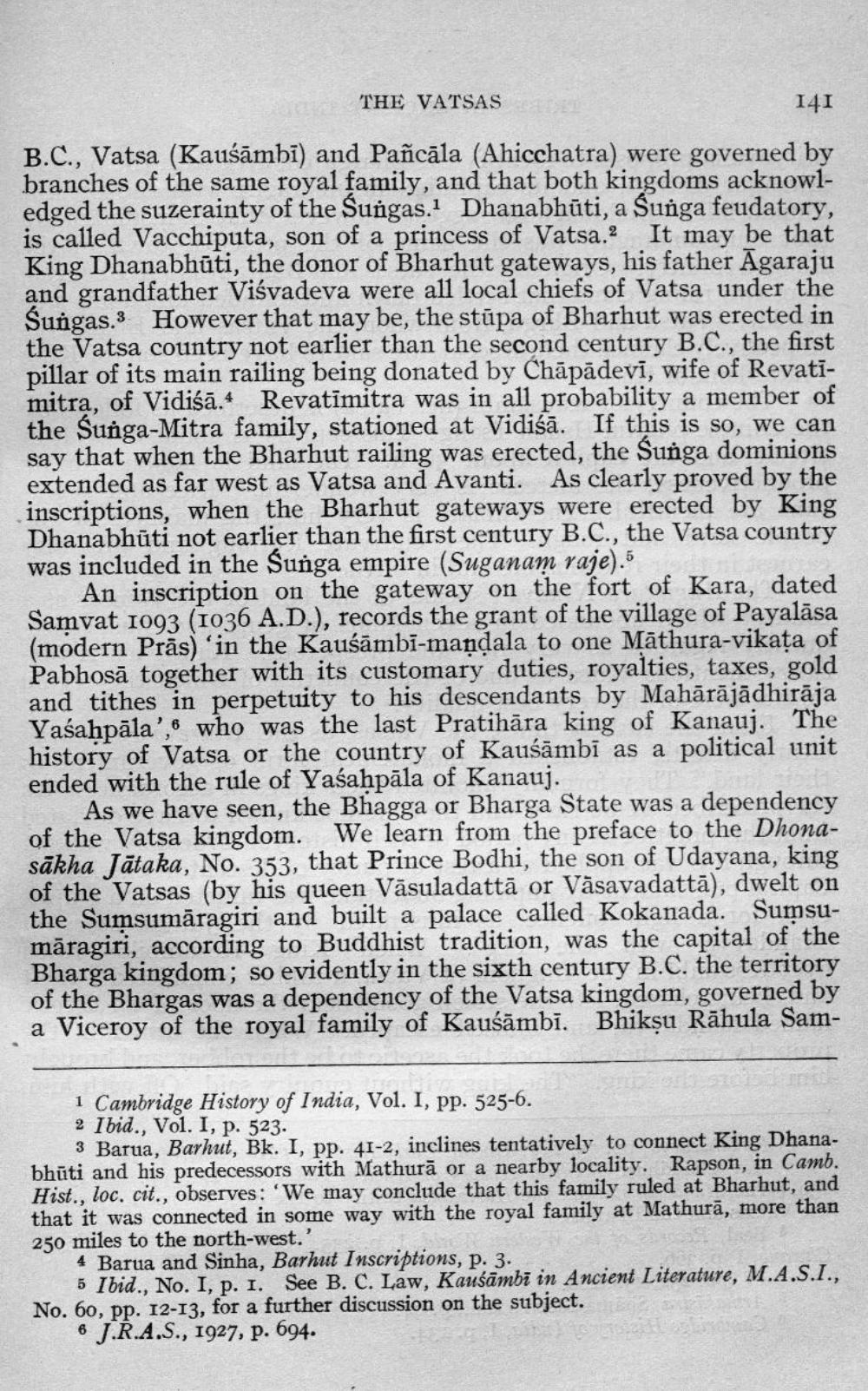________________
THE VATSAS
141 B.C., Vatsa (Kaušāmbī) and Pañcāla (Ahicchatra) were governed by branches of the same royal family, and that both kingdoms acknowledged the suzerainty of the Sungas.1 Dhanabhūti, a Sunga feudatory, is called Vacchiputa, son of a princess of Vatsa.2 It may be that King Dhanabhūti, the donor of Bharhut gateways, his father Āgaraju and grandfather Viśvadeva were all local chiefs of Vatsa under the Sungas.3. However that may be, the stūpa of Bharhut was erected in the Vatsa country not earlier than the second century B.C., the first pillar of its main railing being donated by Chāpādevī, wife of Revatimitra, of Vidiśā.4 Revatimitra was in all probability a member of the Sunga-Mitra family, stationed at Vidiśā. If this is so, we can say that when the Bharhut railing was erected, the Sunga dominions extended as far west as Vatsa and Avanti. As clearly proved by the inscriptions, when the Bharhut gateways were erected by King Dhanabhūti not earlier than the first century B.C., the Vatsa country was included in the Sunga empire (Suganam raje).5
An inscription on the gateway on the fort of Kara, dated Samvat 1093 (1036 A.D.), records the grant of the village of Payalāsa (modern Prās) in the Kausāmbī-mandala to one Māthura-vikata of Pabhosā together with its customary duties, royalties, taxes, gold and tithes in perpetuity to his descendants by Mahārājādhirāja Yaśahpāla',6 who was the last Pratihāra king of Kanauj. The history of Vatsa or the country of Kaušāmbi as a political unit ended with the rule of Yaśahpāla of Kanauj.
As we have seen, the Bhagga or Bharga State was a dependency of the Vatsa kingdom. We learn from the preface to the Dhonasākha Jātaka, No. 353, that Prince Bodhi, the son of Udayana, king of the Vatsas (by his queen Väsuladattā or Väsavadattā), dwelt on the Sumsumāragiri and built a palace called Kokanada. Sumsumāragiri, according to Buddhist tradition, was the capital of the Bharga kingdom; so evidently in the sixth century B.C. the territory of the Bhargas was a dependency of the Vatsa kingdom, governed by a Viceroy of the royal family of Kaušāmbi. Bhiksu Rāhula Sam
1 Cambridge History of India, Vol. I, pp. 525-6. 2 Ibid., Vol. I, p. 523.
3 Barua, Barhut, Bk. I, pp. 41-2, inclines tentatively to connect King Dhanabhūti and his predecessors with Mathurā or a nearby locality. Rapson, in Camb. Hist., loc. cit., observes: 'We may conclude that this family ruled at Bharhut, and that it was connected in some way with the royal family at Mathurā, more than 250 miles to the north-west.'
4 Barua and Sinha, Barhut Inscriptions, p. 3.
5 Ibid., No. I, P. I. See B. C. Law, Kaušāmbi in Ancient Literature, M.A.S.I., No. 60, pp. 12-13, for a further discussion on the subject.
6 J.R.A.S., 1927, p. 694.




